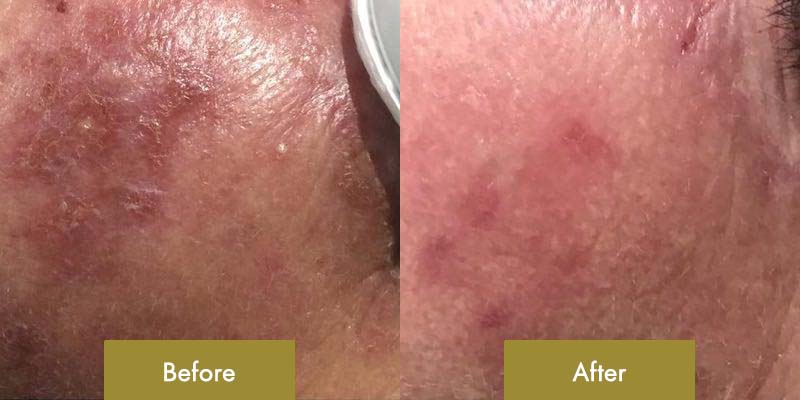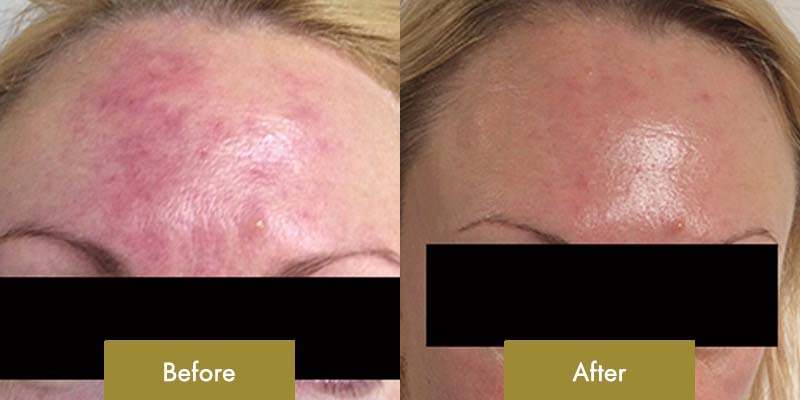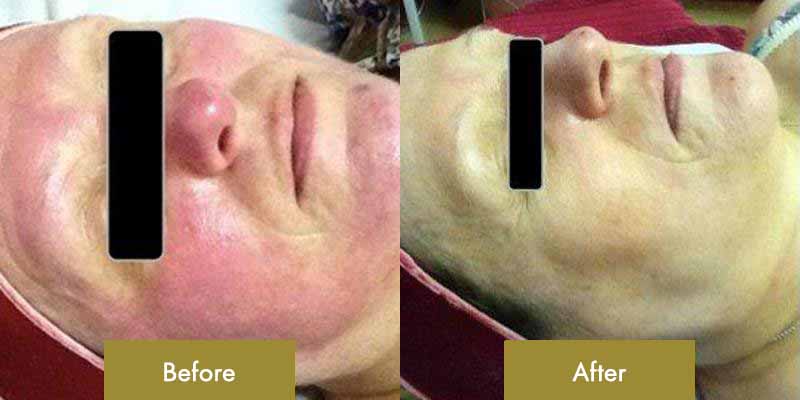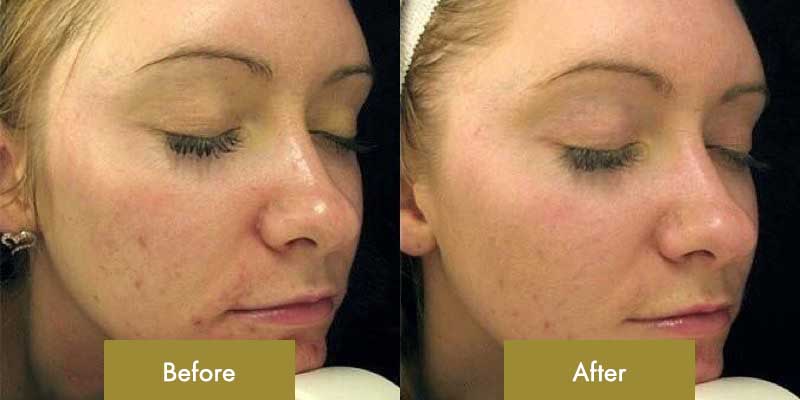Dermalux® is an innovative, clinically proven treatment that rejuvenates the skin using non-invasive light, accelerating cell renewal and improving skin health, thus curing acne!
Complete Acne Treatment Plan with or without medication

Complete diagnosis of the causes of Acne

Photodynamic Therapy for Acne with the award-winning Dermalux®

Personalised treatment plan after thorough examination
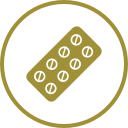
Numerous therapeutic options – Top Medical Technology

Your skin can be clear and smooth almost like acne-free skin

Correction of Acne Scars with ultra-pulse Laser
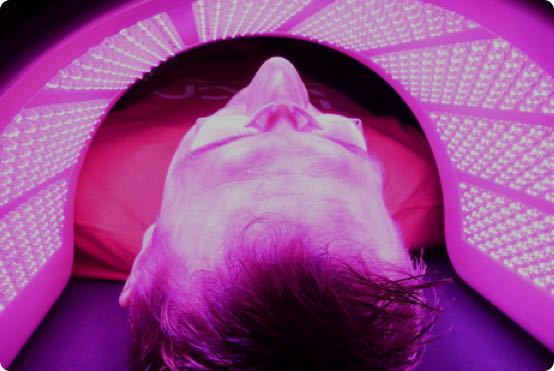
PHOTOTHERAPY (WITH OR WITHOUT MEDICATION)
With the Power of Light – From the 1st Session, Dermalux® activates instantly skin’s growth factors.
Clinically Proven Efficacy
Opposite to other Technologies, Dermalux® does not cause skin irritation. On the contrary, it is beneficial and activates the skin’s natural regeneration mechanisms. It is suitable for all Skin types and no recovery time is required. You can return to your activities straight away.
The 3 Beneficial Light Waves of Dermalux®
Dermalux®: Blue light
- It has natural antibacterial and anti-acne action and bacteria cannot develop resistance, contrary to the use of antibiotics in creams or pills
- Improves skin texture and smooths pigmented blemishes (melasma, post-inflammatory acne blemishes etc.)
- Balances sebum production
- Improves skin clarity
- It has anti-inflammatory action
Dermalux®: Red light
- Boosts collagen and elastin production
- Reduces fine lines and wrinkles
- Increases vital hydration
- Improves skin texture uniformly
- Revitalises and restores radiance
Dermalux®: Near Infrared Light
- Advanced skin rejuvenation
- Soothes redness and irritation
- Reduces skin pigmentation
- Promotes healthy skin
- Ideal for the most sensitive skins
Dermalux®: Tri-Wave Therapy
- Dermalux® Tri-Wave Therapy produces unique wavelengths, adapted and suitable for your skin. Your dermatologist will advise you on the best treatment, depending on your personal needs.
DERMADVANCE MEDICAL CLINICS
What is acne?
Acne is a condition that affects the skin’s sebaceous glands. Skin pores are connected to the sebaceous glands below the skin. These glands produce an oily substance called sebum. The pores are connected with the glands through a channel called hair follicle. Within the follicles, sebum transfers the dead cells on skin surface.
A thin hair is also growing through the follicle. When the skin gland’s follicle is obstructed, acne lesions develop.
Acne usually develops on the face, neck, back, chest and shoulders. Although acne is not a serious threat to the health, yet it can lead to scarring.
What is the cause of acne?
Acne appears when a skin pore becomes clogged. Normally, dead skin cells rise to the surface of a pore and the body removes them.
But when excess sebum is produced, dead cells stick together inside the pore, and instead of rising to the surface, cells block the pore. Inside the pore, bacteria have the perfect environment for very quick multiplication. With the increased bacteria inside the pore, inflammation develops, and the pores become red and swollen. If the inflammation goes deep into the skin, an acne cyst or nodule appears. There are many types of lesions. The most common types are:
- Comedones(whiteheads and blackheads). Whiteheads are below the skin surface, while the blackheads are on the surface of the skin after opening the pore.
- Papules. Small pink bumps, sensitive to touch.
- Pustules. Red colour at the lower part with pus on top.
- Nodules. Big, painful, solid deep in the skin.
- Cysts. Depp, painful, full of pus, can lead to scarring.
The cause of acne is multifactorial. It has been demonstrated that certain factors cause it:
- Increase in hormones during puberty
- Hormonal changes during pregnancy
- Initiation or discontinuation of contraceptive pills
- Heredity
- Certain types of medicines (lithium)
- Oily skin care and make-up products
What factors affect acne?
Factors with a negative influence on acne:
- Hormonal level changes in adolescent and adult women 2-7 days before the commencement of their menstrual cycle
- Pressure posed by helmets, backpacks or tight collars
- Environmental pollution and high levels of humidity
- Pressure with fingers on the lesions
- Vigorous rubbing of the skin
At what age does acne appear?
Acne is the most common skin condition. Acne develops on people of all races and ages, even children (childhood acne), but it is more common in adolescents and young adults.
It is estimated that 80 percent of all people between the ages of 11 and 30 years have an outbreak of acne. Some of them still have acne even in their 40s or 50s.
How long does acne last?
Acne reoccurs in case of treatment discontinuation. Therefore, after the completion of the treatment cycle, it is usual to follow a maintenance treatment schedule to prevent the resurgence of acne.
The usual maintenance treatment period is 4-5 years. This is usually until the end of puberty or the early 20s. In a small number of cases, acne persists after the age of 30 or even later than that.
For these people it is possible to continue treatment so as to control acne and avoid the development of scarring of the skin.
How does acne manifest?
To diagnose acne, the dermatologist will firstly examine the skin to confirm that it is actually acne. There are some conditions that resemble acne. If you have acne, the dermatologist will do the following:
- Diagnose the grade of acne. Grade 1 indicates mild acne. Grade 4 indicates severe acne.
- Record the type or types of acne that are present on the skin.
Dermatologists classify the types of acne in four grades, depending on its manifestation. Determining the grade can be achieved by simple visual examination of the skin.
The special criteria used to classify the symptoms of acne are:
- presence of non-inflammatory comedones
- presence of inflammatory comedones
- severity of exacerbation
- severity of inflammation
- body areas with acne
The main types of acne
Identifying the grade of acne is an important step in acne treatment. Different treatment methods are required for each grade or type of acne. Understanding the quality of acne will help in choosing the right and most effective therapy.
Type or Grade 1 The mildest form of acne. A few pimples are present, appearing very rarely. Many comedones (blackheads and whiteheads) may sometimes be present, but no inflammation. Often, this type of acne is observed at the onset of puberty, especially on the nose and/or forehead.
In adults, Grade 1 acne usually manifests with blackheads on the nose and the forehead. Whiteheads are usually present in the area around the eyes and the chin.
This type of acne can be successfully treated using a local product. Acne should be treated at this stage to avoid its progression.
Type or Grade 2 It is considered as mild acne. Larger number of comedones. Common appearance of papules and pustules at this stage, and in general exacerbation of acne is observed. Mild skin inflammation is now evident.
During puberty, you may be able to see the progress of acne on the nose and the forehead, as well as other areas of the face. Acne may start affecting the chest and shoulders, with occasional exacerbation on the back, especially among male adolescents. Greater exacerbation of acne on the cheeks, the chin and the mandibular region of adult women, especially just before and during menstruation.
Grade 2 acne can also be treated using special topical products. Apart from products with salicylic acid, benzoyl peroxide lotion should be used on a daily basis to help in the elimination of inflammation-causing bacteria. However, if after several weeks of acne treatment at home no significant improvement is observed, you should consult again your dermatologist. This type of acne can progress to Grade 3 acne, especially if you are squeezing the lesions.
Type or Grade 3 This type of acne is considered serious. The main difference between Grade 2 and Grade 3 acne is the size of the existing inflammation. Now the skin is visibly red and inflamed. Greater number of papules and pustuleshave already developed, while nodules usually appear, too.
Type 3 usually affects other areas of the body, too, such as the neck, chest, shoulders and/or the upper part of the back, as well as the face. The possibility of scarring increases as the infection spreads and becomes deeper.
At this stage treatment should be intense and continuous by a dermatologist. This type of acne can be treated with topical and systemic therapies administered with medical prescription. If left untreated it will progress to Grade 4 acne.
Type or Grade 4 The most serious type of acne is often called cystic acne. Many papules, pustules, nodules and cysts develop on the skin. Intense inflammation is present, while serious exacerbations are also evident. Cystic acne is very painful.
Grade 4 acne usually extends beyond the face, and it may affect all of the back, as well as the chest, shoulders and arms. Deep and extended infection is evident. Almost all persons with cystic acne develop scars at various grades.
This type of acne should be treated by a dermatologist. Usually it is difficult to control it, and almost always potent systemic therapy is required, apart from topical treatments.
Why should I treat my acne?
Myths concerning acne are as common as the incidence of the condition.
The most common myth is that acne should not be treated, so as to subside on its own after its cycle is complete.
The dermatologist knows that leaving acne untreated is not the right thing to do because:
- Without treatment, skin pigmentation and permanent scars may appear on the skin as acne subsides.
- Acne treatment usually enhances a person’s self-esteem.
- Many effective treatments are available.
How is the appropriate acne treatment selected?
Treatment aims at eliminating the lesions as much as possible, and preventing the development of scars. There are various types of treatment that work in different ways. The dermatologist will advise you on the treatment methods depending on acne severity and the type of acne. Treatments may be topical or oral systemic or combination treatments.
Acne Treatment
The administration of medicines may be essential to treat acne. Systemic treatment for acne is usually required to eliminate or reduce acne lesions, such as cysts and nodules. The dermatologist may prescribe one or more of the following:
- Antibiotics, help in the elimination of bacteria and inflammation reduction.
- Contraceptive pills and other medicines affecting hormones may help women with hormone-dependent acne.
- Orally administered retinoids, which can target all 4 factors causing acne.
- Photodynamic Therapy for Acne
Procedures that treat acne. Your dermatologist can treat acne with a procedure that can be performed during a visit at the medical practice. These treatments include:
- Laser treatments: These devices reduce the number of P. Acnes bacteria. After the examination and evaluation, it is possible to determine if this type of treatment could be useful.
- Chemical peeling: You can not buy the chemical peels used by dermatologists. Dermatologists use chemical peels to treat two types of acne lesions – comedones and papules.
- Fractional CO2 Laser: Effective method to improve skin texture and residual scars using high-tech invasive lasers (laser dermabration). Usually local anaesthesia is used to perform the procedure. After the treatment of acne and for a few days (3 to 7 days), erythema (redness) develops on the treated area. In addition, following acne treatment sun exposure should be avoided for the time period specified by the dermatologist, Dr Christos Stamou.
What is Photodynamic Therapy for acne;
Photodynamic therapy for acne is a quick and effective method to control acne and clean the skin. Orally administered medicines are not required, nor the long-term use of antibiotics, for which strict compliance is required, while the risk of developing resistance to antibiotics or other complications is eliminated.
Photodynamic Therapy (PDT) is a particularly effective and potent treatment performed in the medical office. PDT controls persistent active acne, combining light and a light-activated special solution targeting and eradicating the activity of acne. PDT eliminates also older spots, and the skin becomes smoother. Advantages:
- Quick treatment of the acne lesions on the face
- No scarring
- No surgical excisions
- No systemic side effects
- The skin looks rejuvenated and younger
What are the adverse events of topical treatment?
The use of certain topical products for acne that contain benzoyl peroxide or salicylic acid as the active ingredient can rarely cause allergic reaction or serious irritation, but they are severe if they occur. An active ingredient is the ingredient that makes the drug effective against a disease or condition to be treated. Other side effects include burning, dryness, itching, flaking, redness, and mild oedema (swelling) on the areas where the product is applied. If side effects occur, you should consult your treating dermatologist.
*Specific results cannot be guaranteed and the results may differ.

